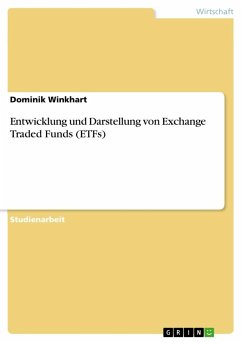Seminar paper from the year 2013 in the subject Business economics - Banking, Stock Exchanges, Insurance, Accounting, grade: 1, University of Innsbruck (Banking and Finance), course: Management von Preis-, Zins- und Währungsrisiken, language: English, abstract: It seems to be common that financial products are developed further and further, making them more and more complex. This process sometimes continues until nobody is any more able to exactly assess the contained risks. Such a trend can currently be observed in the Exchange Traded Funds business where especially active managed ETFs increasingly become unpredictable. This is most harmful for non-professionals and privates who clearly do not fully understand those products and their ramifications. Based on the few material that is currently available in this field "Active Management in ETFs - Possibilities and risk factors" provides new insights about the risks of active management in ETFs. It is most important to early highlight and understand upcoming risks before it is already too late, as it has been the case several times before for other highly innovative and strongly growing financial products.Constructing on the first paper about ETFs from Baumgartner and Hosp (2013), which gave a broad overview about the basics of ETFs and their risks, this paper focuses on the possibilities of active asset management in ETFs and their risks. A huge innovation process currently occurs in the ETF business and broad up actively managed ETFs and managed ETF portfolios. These type of funds very quickly obtained popularity and thus it is one of the latest topics. The paper is structured as follows: After the introduction an overview about the development of active management in ETFs is given. Ongoing section 3 describes active ETFs and compares them with mutual funds in mainly three aspects: costs, transparency and liquidity. Section 4 continues with managed ETF portfolios followed by a short outlook on the development of the active ETF business in section 5 and a conclusion in section 6.
Hinweis: Dieser Artikel kann nur an eine deutsche Lieferadresse ausgeliefert werden.
Hinweis: Dieser Artikel kann nur an eine deutsche Lieferadresse ausgeliefert werden.








